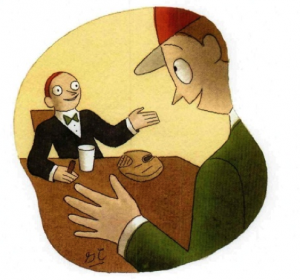Learning this class, I always find it very interesting and useful when we learn about the dynamics of marketing strategy. Through the modules, I have found it useful to read about the history and theories behind marketing communication, but I always learn a great deal when I see these theories applied to current situations and compare how it has changed so much.
Traditional methods of presentations have been a one-way communication from presenters to audiences, and these presentations have advanced throughout history in different ways to use boards, posters, and now power point presentations. However, presentations of ideas need to be marketed more creatively and uniquely to get the attention from your audiences.
 Kimberly D. Elsbach’s “How to Pitch a Brilliant Idea” from Harvard Business Review does just that. She reviewed thousands of presentations and observed top Hollywood producers, venture capitalists, executives, and other investors on their method of picking their investments. Interestingly, she points out that the investors don’t even have a standard method of analyzing the presentation, and thus apply a set of subjective and inaccurate criteria at the early stages of the presentation. She even stated that investors judge a presenter’s traits within less than 50 milliseconds (Elsbach, 2003)! This comes from a long line of researchers of psychology that we all use a set of stereotypes to categorize strangers (Berkowitz, 1977). The investors generally rely on these stereotypes and preconceptions and often overlook good, creative ideas by focusing too much on the individual. Thus, her article reminds us that again, presenters’ traits and the art of pitching are extremely important as much as their ideas.
Kimberly D. Elsbach’s “How to Pitch a Brilliant Idea” from Harvard Business Review does just that. She reviewed thousands of presentations and observed top Hollywood producers, venture capitalists, executives, and other investors on their method of picking their investments. Interestingly, she points out that the investors don’t even have a standard method of analyzing the presentation, and thus apply a set of subjective and inaccurate criteria at the early stages of the presentation. She even stated that investors judge a presenter’s traits within less than 50 milliseconds (Elsbach, 2003)! This comes from a long line of researchers of psychology that we all use a set of stereotypes to categorize strangers (Berkowitz, 1977). The investors generally rely on these stereotypes and preconceptions and often overlook good, creative ideas by focusing too much on the individual. Thus, her article reminds us that again, presenters’ traits and the art of pitching are extremely important as much as their ideas.
Then she categorizes presenters in three prototypes: showrunner, artist, and neophyte (Elsbach, 2003). These three protoypes are what she categorizes as the most successful, and states that 85 percent of these prototypes make up the successful projects. The three prototypes all have very unique characteristics, but goes to show that they are all about creating an appealing conversation with your audience.
Showrunners are those who come off as professionals who have experience and apply creativity in to their field of expertise. Thus, they show an array of charisma, intelligence of the business field, and the know-how of business standards and resources that need to used. Simply, they know their stuff really well, and the author stated showrunners “create a level playing field by engaging the catcher in a kind of knowledge duet” (Elsbach, 2003). This way investors feel confident in investing in the person. When I think of showrunners, I usually think of people like Steve Jobs and Bill Gates who have been through the rough business courses, know their product really well, and ask for exactly what they need.
 Artists are those who don’t have a detailed implementation plan, but use creativity to their advantage. For example, instead of using slides and powerpoints, one presenter presented his idea by spilling cereal into the conference table and challenged the investors to build the tallest tower with the cereal. He was giving the idea that children like to play with their food (Elsbach, 2003). This way the investors are engaged in the presentation, thinking the idea, touching it, and using their own imagination. Contrast to the showrunners, they do less talking and appear shy to be in their own world. The author stated 40 percent of the successful presenters she observed were artists (Elsbach, 2003).
Artists are those who don’t have a detailed implementation plan, but use creativity to their advantage. For example, instead of using slides and powerpoints, one presenter presented his idea by spilling cereal into the conference table and challenged the investors to build the tallest tower with the cereal. He was giving the idea that children like to play with their food (Elsbach, 2003). This way the investors are engaged in the presentation, thinking the idea, touching it, and using their own imagination. Contrast to the showrunners, they do less talking and appear shy to be in their own world. The author stated 40 percent of the successful presenters she observed were artists (Elsbach, 2003).
Neophytes, unlike showrunners, act as if they are innocent, naïve, young, and inexperienced. They present themselves as if they are new to the field, act as a student, and ask the investors to help them in different ideas as they explore the impossible. In the example in the article, the presenter just came back from Japan and wanted to create a film about an American (like him) in a foreign country learning to play drums. While he was playing different styles of drums, he asked the audience for recommendations on the different camera angles that could be filmed and recorded. This way the audience was engaged and spent their time teaching the presenter about various lighting and sound methods (Elsbach, 2003).
Is there a way to counteract quick judgment? The author’s main argument that I described is to make the audience feel like they are participating in the presenter’s idea. For example, a presenter can give a series of pictures and viewpoints and then ask the investors for their reactions. She mentions that when presenter gives an opportunity for the investors to collaborate with them, the presenters are “seducing” them. This way, they forget about stereotyping the person into a small category and start focusing on the idea itself. There are many ways to do this and the author just presented three successful categories. Do you have other ideas and experiences in engaging? What do you think about the author’s point of view?
Elsbach, K. (2003, September). How to Pitch a Brilliant Idea. Harvard Business Review, 9. Retrieved February 25, 2013, from http://hbr.org/2003/09/how-to-pitch-a-brilliant-idea/ar/1
Berkowitz, L. (1977). Advances in Experimental Social Psychology, 10. Burlington: Elsevier.
Written by Yeirang Lee.

3 Responses to Can’t Just Present, Got to Represent